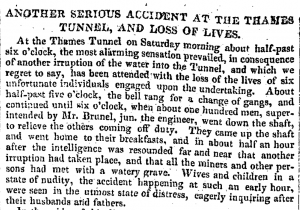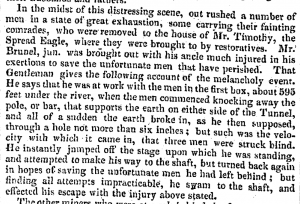On this day in 1828, the Thames Tunnel flooded for the second time, badly injuring and nearly killing young Isambard Kingdom Brunel, and bringing an end to the lives of six other men working on the project.
The workers Isambard had been assisting with shoring, Collins and Ball, did not make it out alive. They were later found crushed under the bricklaying platform. Isambard managed to get free, but the tunnel was rapidly filling with water. He called out to make for the shaft, nearly 600ft of tunnel away, as he struggled in that direction through the watery darkness.
Everyone who could rushed for the stairs. However, before Isambard, in his injured state, could make it up them “he was swept up by an immense wave which came sweeping along the tunnel. On reaching the shaft it was forced upwards, actually reaching the very top of the 42-ft Rotherhithe shaft. As it did so, it bore Isambard’s battered body up to safety”. Whilst he survived the event, it was later discovered that not only was Isambard’s leg injured, but he had grave internal injuries requiring a long convalescence.
Different newspapers of the time have rather differing reports of events (a reminder useful in the modern world to always be wary of your sources). Here is an excerpt from the Derby Mercury published 4 days after the flood:

ANOTHER SERIOUS ACCIDENT AT THE THAMES
TUNNEL, AND LOSS OF LIVES
At the Thames Tunnel on Saturday morning about half-past
six o’clock, the most alarming sensation prevailed, in consequence
of another irruption of the water into the Tunnel, and which we
regret to say, has been attended with the loss of lives of six
unfortunate individuals engaged upon the undertaking. About
half-past five o’clock the bell rang for a change of gangs, and
continued until six o’clock, when about one hundred men, super-
intended by Mr. Brunel, jun. the engineer, went down the shaft,
to relieve the others coming off duty. They came up the shaft
and went home to their breakfasts, and in about half an hour
after the intelligence was resounded far and near that another
irruption had taken place, and that all the miners and other per-
sons had met with a watery grave. Wives and children in a
state of nudity, the accident happening at such an early hour,
were seen in the utmost state of distress, eagerly enquiring after
their husbands and fathers.

In the midst of this distressing scene, out rushed a number of
men in a state of great exhaustion, some carrying their fainting
comrades, who were moved to the house of Mr. Timothy, the
Spread Eagle, where they were brought to by restoratives. Mr.
Brunel, jun. was brought out with his ankle much injured in his
exertions to save the unfortunate men that have perished. That
Gentleman gives the following account of the melancholy event.
He says that he was at work with the men in the first box, about 595
feet under the river, when the men commenced knocking away at the
pole, or bar, that supports the earth on either side of the Tunnel,
and all of a sudden the earth broke in, as he then supposed,
through a hole not more than six inches; but such was the velo-
city with which it came in, that three men were struck blind.
He instantly jumped off the stage upon which he was standing,
and attempted to make his way to the shaft, but turned back again
in hopes of saving the unfortunate men he had left behind; but
finding all attempts impracticable, he swam to the shaft, and
effected his escape with the injury above stated.
I should note here that the Spread Eagle was the contemporary name of the Mayflower public house. So everyone went to the pub to recover!
Whilst much of the attention is focused on Isambard, the men who died in the flood are also mentioned. This was a tragic loss of life. That said, it is impressive that, given the speed of the water, almost everyone escaped.

The names of the unfortunate sufferers are:- Thomas Ball,
leaving a wife, but no family; J. Long, a wife, but no family;
Thomas Collins – a wife and two children; Jeptha Cook – six
children, orphans; George Evans, a single man; and a person
named Lincoln, a single man, who had not been long on the
works.
Some accounts say that a diving bell was called for immediately, and was in operation by early that evening, some say it was into the night before the damage could be inspected.
We do know that Isambard went to Brighton to recuperate, and rather enjoyed the social life at first, then took a turn for the worse (suffering the first of a series of haemorrhages) and was sent to the rather more sedate Clifton (Bristol).
How different would our landscape and infrastructure be if Isambard had died on this, his first major project? Discover the story of the Thames Tunnel flood in a visit to the Museum today.
